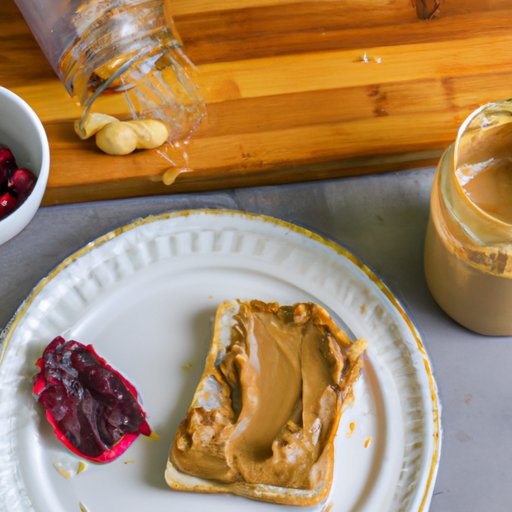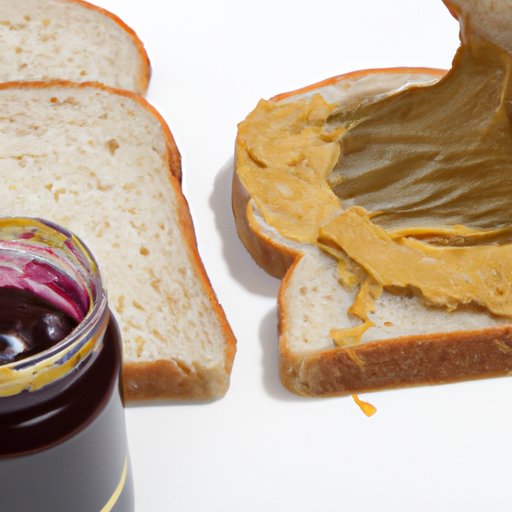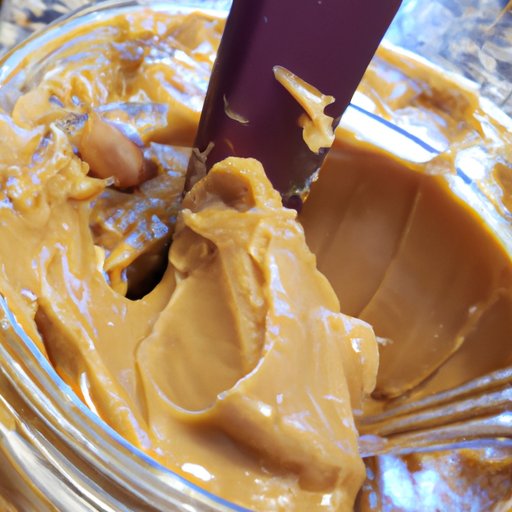Introduction
Peanut butter and jelly sandwiches have been a staple in lunch boxes for generations, but is this classic combo good for you? In this article, we’ll explore the nutritional benefits and drawbacks of this beloved snack. We’ll also take a look at how to make a healthier version of the sandwich, as well as explore the potential health risks associated with eating peanut butter and jelly.
Nutritional Benefits of Peanut Butter and Jelly
The nutritional benefits of peanut butter and jelly depend on the ingredients used in the sandwich. Peanut butter is a good source of protein and fiber, as well as certain vitamins and minerals such as vitamin E, magnesium, and potassium. The jelly adds some additional nutrition, depending on the type you use. For instance, raspberry jam is a good source of antioxidants and other beneficial nutrients such as iron and vitamin C.
Is Peanut Butter and Jelly a Healthy Snack?
There are both pros and cons to eating peanut butter and jelly. On the plus side, it’s a relatively inexpensive snack that’s easy to make and requires no cooking. It’s also a good source of protein and fiber, which can help keep you full and energized throughout the day.
On the downside, peanut butter and jelly can be high in fat and sugar, depending on the types of ingredients used. Many store-bought jellies and jams contain added sugar, while some peanut butters may contain added oils and sweeteners. Eating too much of these items can lead to weight gain and an increased risk of chronic diseases such as diabetes and heart disease.

How to Make a Healthier Version of Peanut Butter and Jelly
If you’re looking to make a healthier version of the traditional PB&J sandwich, there are a few simple swaps you can make. First, opt for whole grain bread instead of white bread. Whole grains are a good source of fiber, which can help keep you feeling fuller for longer.
Next, choose natural peanut butter instead of processed varieties. Natural peanut butter is made with just peanuts and salt, so you won’t have to worry about added sugars or oils.
Finally, select low-sugar jams and jellies. Many store-bought versions contain added sugar, so it’s best to opt for a brand that uses natural sweeteners like honey or stevia.
Peanut Butter and Jelly: A Balanced Meal?
When making your own PB&J, you can also add additional nutrients to make it a more balanced meal. Adding vegetables like lettuce, tomato, or cucumber can increase the fiber content and provide additional vitamins and minerals. You can also add slices of cheese or a hard-boiled egg to add protein and other essential nutrients.
By combining different foods, you can create a nutritionally complete meal that will keep you satisfied until your next meal.
Peanut Butter and Jelly: An Allergy-Friendly Snack?
For people with food allergies, peanut butter and jelly may not be the best option. Peanuts are one of the eight major allergens, and even trace amounts can cause severe reactions in some people. Fortunately, there are a few alternatives that can be used in place of peanuts. Sunflower seed butter, soy nut butter, and almond butter are all safe options for those with peanut allergies.
For those with allergies to tree nuts, there are also allergen-free options available. Coconut butter and tahini are both nut-free and can be used in place of peanut butter.

Exploring the Health Risks of Peanut Butter and Jelly
In addition to allergy concerns, there are other potential health risks associated with eating peanut butter and jelly. For example, peanut butter can be high in fat, so it’s important to watch your portion sizes. Additionally, many store-bought jellies and jams contain added sugar, which can contribute to weight gain and an increased risk of diabetes and heart disease if consumed in excess.
It’s also important to check the labels of any peanut butter or jelly products you buy, as some brands may contain trans fats, artificial colors, or other unhealthy additives.
Conclusion
In conclusion, peanut butter and jelly can be a nutritious snack when made with the right ingredients. Opt for whole grain bread, natural peanut butter, and low-sugar jams and jellies to get the most nutritional benefit from your sandwich. Additionally, adding additional ingredients like vegetables, cheese, or eggs can boost the nutritional profile of your PB&J. Just be sure to watch your portion sizes and check labels for unhealthy additives. For those with allergies, there are plenty of nut-free and allergen-free alternatives available. With a few simple swaps, you can enjoy a delicious and nutritious peanut butter and jelly sandwich!
(Note: Is this article not meeting your expectations? Do you have knowledge or insights to share? Unlock new opportunities and expand your reach by joining our authors team. Click Registration to join us and share your expertise with our readers.)
